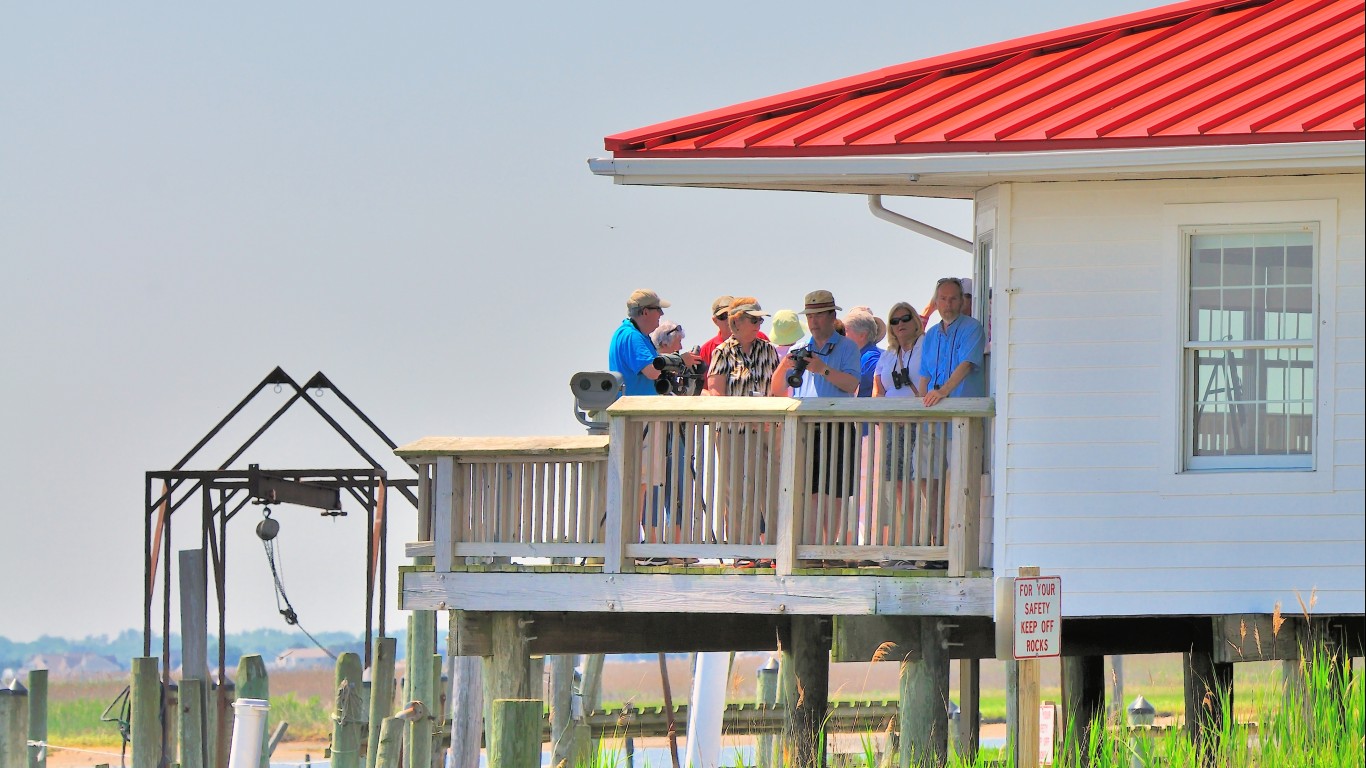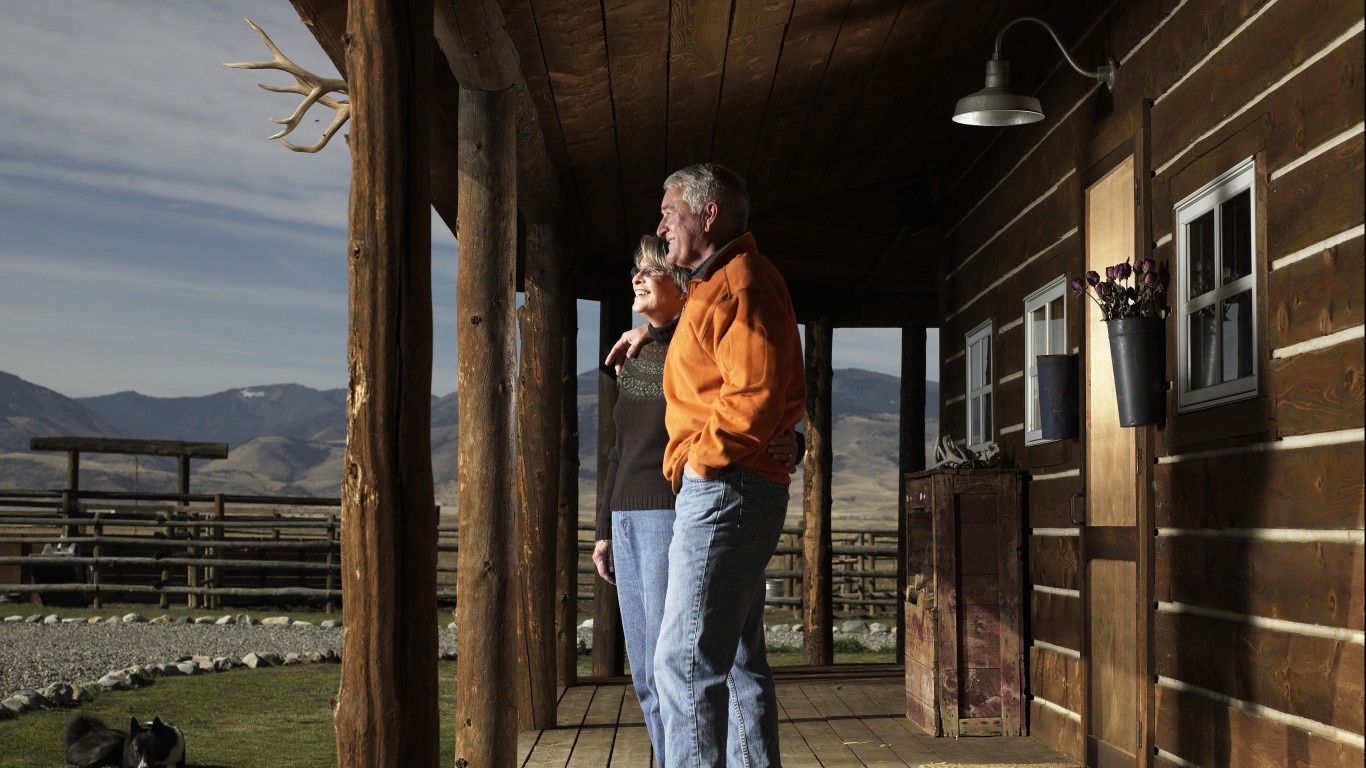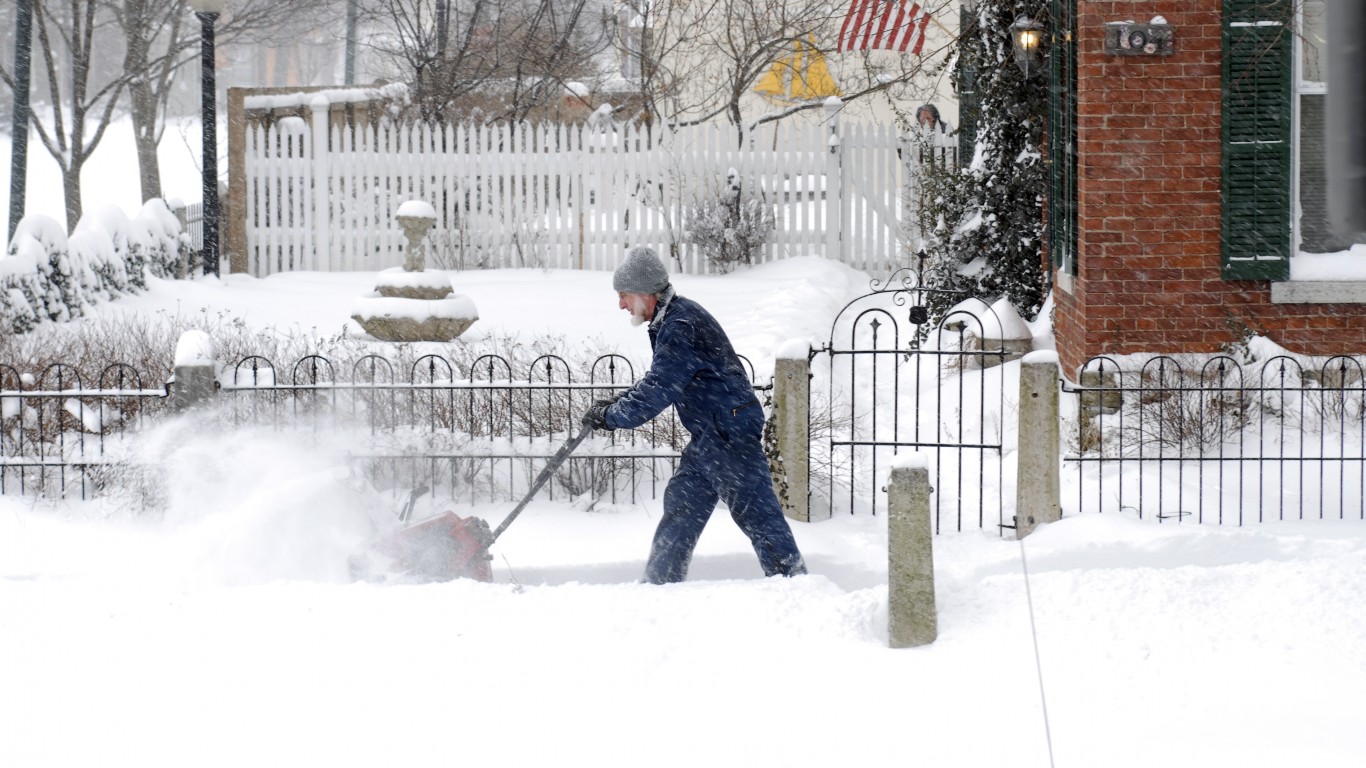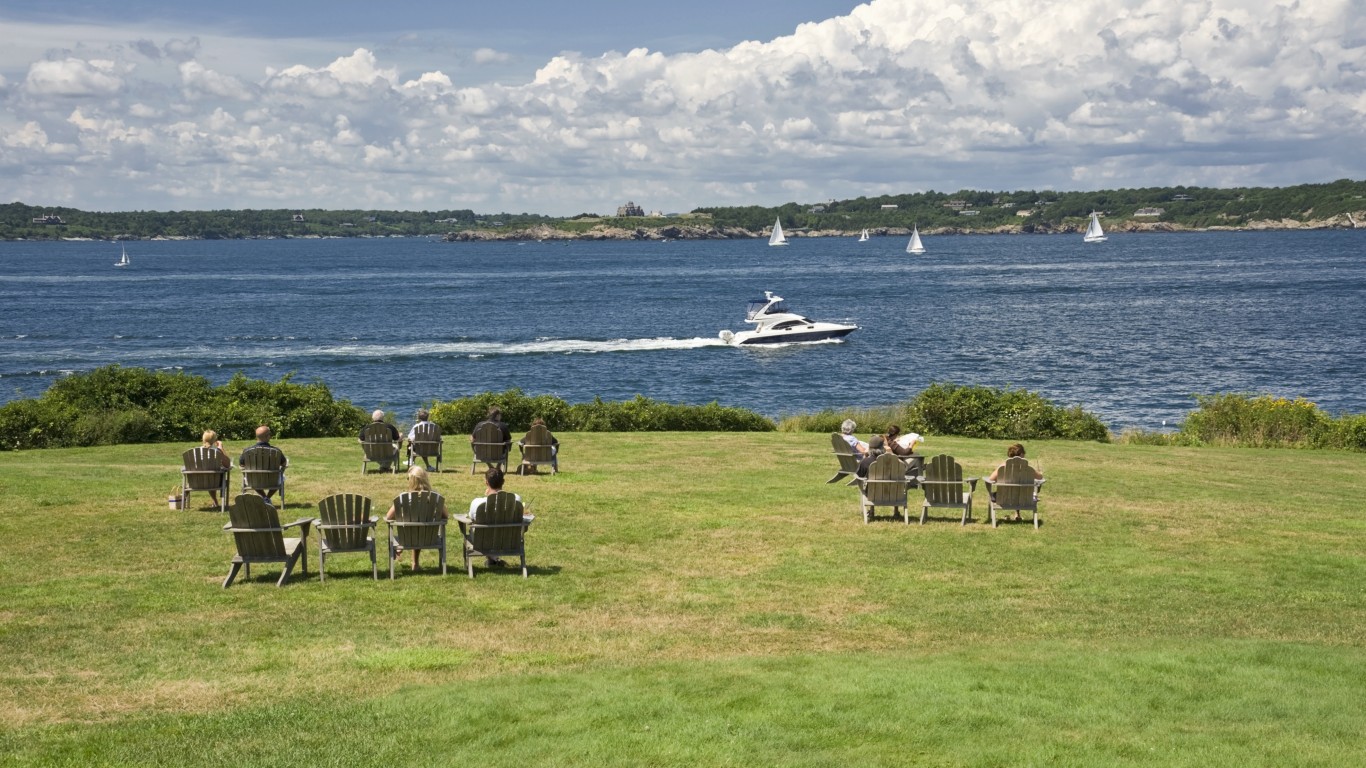
A 2019 report from the Federal Reserve found that nearly one in every four American adults have no retirement savings. During the economic crisis brought on by the COVID-19 pandemic, that share has likely grown. Despite stimulus payments and enhanced unemployment benefits, millions of Americans have reduced retirement account contributions or stopped them entirely — some have even been forced to make withdrawals. Here is what you can do if the coronavirus is threatening your retirement.
At age 65, Americans are expected to live an average of another 19.4 years, and the typical retirement-age American spends $50,220 a year. Multiply those figures, and add in a little extra for unforeseen expenses and additional financial security, and a comfortable retirement costs an estimated $1,120,408 in the United States.
Of course, cost of living varies from state to state, as does average life expectancy. As a result, the estimated cost of a comfortable retirement changes as well. Using the average annual spending of Americans 65 and older — adjusted at the state level for cost of living and life expectancy — 24/7 Wall St. calculated what it would cost to retire comfortably in each state. All data used in the ranking came from the Bureau of Economic Analysis, the Bureau of Labor Statistics, and the Institute for Health Metrics and Evaluation, an independent global health research center at the University of Washington.
Depending on the state, the cost of a comfortable retirement varies from as little as $858,000 to as much as $1.5 million. Generally, states in the Northeast and the West tend to be more expensive places to retire, while those in the Midwest and South are less expensive.
It is important to note that these estimated costs are not a reflection of recommended retirement savings, as they do not account for any savings interest or investment income, nor do they account for retirement income, such as pensions or Social Security. In some parts of the country, state and local governments have relatively large budgets for these and other programs, reducing the financial burden of retirement on the individual. Here is a look at the states spending the most to fund their residents’ retirement.
Click here to see what it costs to retire in every state.
Click here to read our detailed methodology.

1. Alabama
> Est. total retirement spending: $877,072 (3rd least)
> Avg. cost of living: 14.2% less than avg. (3rd lowest)
> Median monthly homeownership cost, pop. 65 & older: $358 (6th lowest)
> Pop. 65 & older: 17.4% (20th highest)
In Alabama, goods and services are about 14.2% cheaper than they are on average nationwide. Accounting for the state’s low cost of living, retirement-age residents spend an average of $43,089 annually. Applying this amount to average life expectancy at 65 in Alabama, and accounting for additional unforeseeable expenses that can occur during retirement, it costs $877,072 to retire comfortably in Alabama, about $243,300 less than the average cost nationwide.
[in-text-ad]

2. Alaska
> Est. total retirement spending: $1,159,339 (13th most)
> Avg. cost of living: 5.1% more than avg. (9th highest)
> Median monthly homeownership cost, pop. 65 & older: $536 (15th highest)
> Pop. 65 & older: 12.4% (2nd lowest)
In Alaska, a comfortable retirement for the average resident will cost $1,159,339 — about $39,000 more than the national average. The state’s higher than average projected retirement costs are partially due to the state’s high cost of living. Goods and services are about 5% more expensive in Alaska than they are nationwide, on average.
in Alaska, for example, the typical monthly housing expenses $536 among the 65 and older population without a mortgage, more than in most other states. Over the course of a year, this amounts to about $450 more in housing costs than the typical American retiree without a mortgage spends on housing.

3. Arizona
> Est. total retirement spending: $1,117,884 (18th most)
> Avg. cost of living: 3.7% less than avg. (25th highest)
> Median monthly homeownership cost, pop. 65 & older: $419 (16th lowest)
> Pop. 65 & older: 18.0% (13th highest)
With a warm climate in much of the state, Arizona is an attractive place for many Americans to spend their golden years. Additionally, the cost of a comfortable retirement in Arizona is closely in line with the national average. Accounting for both cost of living and average life expectancy, the average American retiring in Arizona is projected to spend $1,117,884 — only about $2,500 more than the typical U.S. retiree.
Arizona’s population is older than that of the country on average. An estimated 18.0% of state residents are of retirement age, compared to 16.5% of all Americans.

4. Arkansas
> Est. total retirement spending: $875,611 (2nd least)
> Avg. cost of living: 15.3% less than avg. (2nd lowest)
> Median monthly homeownership cost, pop. 65 & older: $348 (4th lowest)
> Pop. 65 & older: 17.4% (22nd highest)
Goods and services in Arkansas are about 15.3% less expensive than average. With a low cost of living, retirement is relatively affordable in the state. Accounting for average annual spending and cost of living, it would cost $875,611 to retire comfortably at age 65 in Arkansas, nearly a quarter of a million dollars less than the national average.
The low retirement costs in Arkansas are also a product of the state’s low life expectancy. On average, 65 year old Arkansas residents are expected to live another 17.9 years, while life expectancy for the typical 65 year old American is 19.4 years.
[in-text-ad-2]

5. California
> Est. total retirement spending: $1,391,547 (2nd most)
> Avg. cost of living: 16.4% more than avg. (2nd highest)
> Median monthly homeownership cost, pop. 65 & older: $588 (11th highest)
> Pop. 65 & older: 14.8% (6th lowest)
In California, goods and services are about 16.4% more expensive than average. With the second highest cost of living of any state, California is not a cheap place to retire. On average, a 65 year old will need about $1.4 million for a comfortable retirement, about $271,100 more than what the typical retiree nationwide will need and the second highest retirement cost of all states.
The high retirement costs in California are also attributable to the long average life expectancy in the state. At age 65, the typical Californian is expected to live another 20.7 years — over a year longer than the typical 65 year old American.

6. Colorado
> Est. total retirement spending: $1,177,006 (12th most)
> Avg. cost of living: 1.9% more than avg. (13th highest)
> Median monthly homeownership cost, pop. 65 & older: $485 (25th highest)
> Pop. 65 & older: 14.7% (5th lowest)
In Colorado, goods and services are about 2% more expensive than average, and life expectancy among retirement age residents is about half a year longer than the national average. As a result, a comfortable retirement will cost an average of $1,177,006 in the state, about $57,000 more than the U.S. average.
Colorado has a relatively small retirement population. Just 14.7% of state residents are 65 or older, compared to 16.5% of all Americans.
[in-text-ad]

7. Connecticut
> Est. total retirement spending: $1,237,069 (7th most)
> Avg. cost of living: 5.0% more than avg. (10th highest)
> Median monthly homeownership cost, pop. 65 & older: $898 (2nd highest)
> Pop. 65 & older: 17.6% (16th highest)
The average 65 year old living in Connecticut can expect to spend a total of about $1,237,000 to retire comfortably — nearly $117,000 more than the typical American. The higher retirement costs in the state are due to both a higher than average cost of living and longer than average life expectancy.
Goods and services in Connecticut cost about 5% more than they do on average nationwide. Additionally, 65 year olds in the state live an average of about a year longer than the typical 65 year old American.

8. Delaware
> Est. total retirement spending: $1,113,686 (19th most)
> Avg. cost of living: 0.6% less than avg. (17th highest)
> Median monthly homeownership cost, pop. 65 & older: $448 (20th lowest)
> Pop. 65 & older: 19.5% (5th highest)
A comfortable retirement in Delaware costs about as much as it does on average nationwide. The average 65 year old in the state will spend an estimated $1,113,686 through retirement, only about $6,700 less than the average American retiree.
Delaware has one of the older populations among states. Nearly one in every five state residents are retirement age, compared to 16.5% of Americans who are 65 or older.

9. Florida
> Est. total retirement spending: $1,184,110 (9th most)
> Avg. cost of living: 1.0% more than avg. (16th highest)
> Median monthly homeownership cost, pop. 65 & older: $516 (20th highest)
> Pop. 65 & older: 20.9% (2nd highest)
With a warm climate, Florida is a popular state for retired Americans to relocate to. For 65 year olds in Florida, a comfortable retirement will cost an estimated $1,184,110, nearly $64,000 more than average nationwide. Rather than a higher cost of living, the high retirement costs in Florida are driven primarily by the high average life expectancy in the state. A 65 year old in the state is expected to live another 20.3 years on average — nearly a year longer than the national life expectancy at 65.
Of the 21.5 million people living in the Sunshine State, 20.9% are 65 and older. Meanwhile, just 16.5% of the U.S. population are in the same age group.
[in-text-ad-2]

10. Georgia
> Est. total retirement spending: $995,777 (15th least)
> Avg. cost of living: 6.8% less than avg. (24th lowest)
> Median monthly homeownership cost, pop. 65 & older: $409 (14th lowest)
> Pop. 65 & older: 14.3% (4th lowest)
In Georgia, goods and services are about 7% less expensive than average, and life expectancy among retirement-age residents is about a year below the national average. As a result, a comfortable retirement will cost an average of $995,777 in the state, about $124,600 less than the U.S. average.
Georgia has a relatively small retirement-aged population. Just 14.3% of state residents are 65 or older, compared to 16.5% of all Americans.

11. Hawaii
> Est. total retirement spending: $1,481,336 (the most)
> Avg. cost of living: 19.3% more than avg. (the highest)
> Median monthly homeownership cost, pop. 65 & older: $534 (16th highest)
> Pop. 65 & older: 19.0% (7th highest)
With the highest cost of living of any state, Hawaii is also the most expensive state in which to retire comfortably. Goods and services in the state are 19.3% more expensive than they are on average nationwide, and the average 65 year old should plan on spending $1,481,336 throughout retirement, nearly $361,000 more than the national average.
A long life expectancy also contributes to the high retirement costs in Hawaii. The typical 65 year old in the state is expected to live an additional 21.5 years, two years longer than the typical 65 year old American.
[in-text-ad]

12. Idaho
> Est. total retirement spending: $1,033,016 (23rd least)
> Avg. cost of living: 7.8% less than avg. (21st lowest)
> Median monthly homeownership cost, pop. 65 & older: $384 (9th lowest)
> Pop. 65 & older: 16.2% (16th lowest)
In Idaho, a comfortable retirement will cost an estimated $1,033,016, about $87,400 less than the average nationwide. Life expectancy at age 65 in Idaho is in line with the national average, and the lower retirement costs in the state are attributable to a lower overall cost of living. Goods and services in Idaho are nearly 8% less expensive than they are on average nationwide.
The share of retirement-age Americans living in Idaho is in line with the national average. Of the state’s 1.8 million residents, 16.2% are 65 or older, compared to 16.5% of all Americans.

13. Illinois
> Est. total retirement spending: $1,096,903 (20th most)
> Avg. cost of living: 2.6% less than avg. (20th highest)
> Median monthly homeownership cost, pop. 65 & older: $617 (8th highest)
> Pop. 65 & older: 16.1% (14th lowest)
A comfortable retirement costs an average of $1,096,903 in Illinois, about $23,505 less than it does on average across the U.S. In Illinois, lower than average retirement costs are attributable to a lower than average cost of living.
The average American age 65 and older spends about $50,200 annually. Adjusting for the state’s relatively low cost of living, this amount is only $48,914 in Illinois.

14. Indiana
> Est. total retirement spending: $942,575 (10th least)
> Avg. cost of living: 11.3% less than avg. (11th lowest)
> Median monthly homeownership cost, pop. 65 & older: $406 (12th lowest)
> Pop. 65 & older: 16.1% (13th lowest)
Indiana is one of only 10 states nationwide where a 65 year old can retire and live comfortably with less than $950,000. The average retirement cost in the state of $942,575 is nearly $178,000 less than the national average.
The affordability of a comfortable retirement is due to the low cost of living in the state. Goods and services are 11.3% cheaper in Indiana than they are on average nationwide. As a result, the average annual expenditure of a retirement age state resident is about $5,700 less than it is across the U.S.
[in-text-ad-2]

15. Iowa
> Est. total retirement spending: $1,002,303 (18th least)
> Avg. cost of living: 11.0% less than avg. (12th lowest)
> Median monthly homeownership cost, pop. 65 & older: $498 (22nd highest)
> Pop. 65 & older: 17.5% (17th highest)
As is the case in much of the Midwest, the cost of living in Iowa is low. Goods and services are 11% less expensive in the state than they are nationwide, on average. Partially as a result, a comfortable retirement for the average 65 year old in the state is projected to cost $1,002,303 — about $118,100 less than average.
Iowa has a slightly older population than the country on average. Of the 3.2 million people living in the state, 17.5% are 65 or older, compared to 16.5% of the U.S. population.

16. Kansas
> Est. total retirement spending: $978,798 (13th least)
> Avg. cost of living: 10.8% less than avg. (13th lowest)
> Median monthly homeownership cost, pop. 65 & older: $512 (21st highest)
> Pop. 65 & older: 16.4% (20th lowest)
For a 65 year old in Kansas whose life expectancy aligns with the statewide average, a comfortable retirement will cost an estimated $978,798, $141,600 less than it does nationwide.
The more affordable retirement in the state is due both to the relatively low cost of living and lower than average life expectancy. Goods and services are nearly 11% less expensive in Kansas than they are nationwide. Additionally, the average 65 year old in Kansas is expected to live another 19 years, about a half a year less than the national average life expectancy.
[in-text-ad]

17. Kentucky
> Est. total retirement spending: $883,332 (5th least)
> Avg. cost of living: 12.6% less than avg. (6th lowest)
> Median monthly homeownership cost, pop. 65 & older: $373 (7th lowest)
> Pop. 65 & older: 16.9% (24th lowest)
Kentucky is one of only five states nationwide where a 65 year old can retire and live comfortably with less than $900,000. The average retirement cost in the state of $883,332 is over a quarter of a million dollars less than the national average.
The affordable and comfortable retirement is due largely to the state’s low cost of living. Housing is particularly inexpensive. The typical retirement-age homeowner without a mortgage spends just $373 a month on housing, well below the comparable $499 monthly median nationwide.

18. Louisiana
> Est. total retirement spending: $918,844 (7th least)
> Avg. cost of living: 12.1% less than avg. (8th lowest)
> Median monthly homeownership cost, pop. 65 & older: $346 (3rd lowest)
> Pop. 65 & older: 16.0% (11th lowest)
Few states are as affordable for retirees as Louisiana. A 65 year old state resident whose life expectancy aligns with the state average is projected to need $918,844 to live out retirement in relative comfort. Nationwide, a retiree will spend about $201,600 more.
The relative affordability of a comfortable retirement is due in part to the state’s low cost of living. Housing is particularly inexpensive. The typical retirement-age homeowner without a mortgage spends just $346 a month on housing, well below the comparable $499 monthly median nationwide.

19. Maine
> Est. total retirement spending: $1,072,421 (22nd most)
> Avg. cost of living: 0.7% less than avg. (18th highest)
> Median monthly homeownership cost, pop. 65 & older: $521 (19th highest)
> Pop. 65 & older: 21.3% (the highest)
Of all six states in New England, Maine is the most affordable for retirees. The average 65 year old can expect to spend $1,072,421 in retirement, about $48,000 less than the national average. In every other state in the region, a comfortable retirement costs anywhere from $26,300 to $148,402 more than the national average.
Maine is a popular state for retirees. Of the 1.3 million people living in the state, 21.3% are 65 or older, the largest share of any state in the country.
[in-text-ad-2]

20. Maryland
> Est. total retirement spending: $1,219,120 (8th most)
> Avg. cost of living: 7.7% more than avg. (7th highest)
> Median monthly homeownership cost, pop. 65 & older: $602 (9th highest)
> Pop. 65 & older: 15.9% (9th lowest)
With a relatively high cost of living, Maryland is also a relatively expensive state in which to retire comfortably. Goods and services in the state are 7.7% more expensive than they are on average nationwide, and the average 65 year old should plan on spending $1,219,120 throughout retirement, nearly $99,000 more than the national average.
Housing costs are especially high in Maryland. The typical retirement-age homeowner without a mortgage spends $602 a month on housing, far more than the comparable $499 monthly median nationwide.

21. Massachusetts
> Est. total retirement spending: $1,268,810 (5th most)
> Avg. cost of living: 10.4% more than avg. (5th highest)
> Median monthly homeownership cost, pop. 65 & older: $803 (4th highest)
> Pop. 65 & older: 17.0% (25th highest)
Massachusetts is the most expensive state in New England to retire in, and the fifth most expensive state nationwide. The average 65 year old in Massachusetts will spend an estimated $1,268,810 to live comfortably throughout retirement, about $148,400 more than the typical 65 year old American.
A long life expectancy partially explains the higher costs in the state, as the typical 65 year old Massachusetts resident is expected to live half a year longer, on average, than the typical 65 year old American. The most consequential factor, however, is the state’s high cost of living. Goods and services are 10.4% more expensive than average in Massachusetts.
[in-text-ad]

22. Michigan
> Est. total retirement spending: $1,007,484 (21st least)
> Avg. cost of living: 7.7% less than avg. (22nd lowest)
> Median monthly homeownership cost, pop. 65 & older: $482 (25th lowest)
> Pop. 65 & older: 17.7% (14th highest)
The average 65 year old retiring in Michigan can expect to spend $1,007,484, nearly $113,000 less than the average cost nationwide.
The affordability of a comfortable retirement in Michigan is due in part to the low cost of living in the state. Goods and services are 7.7% cheaper in Michigan than they are on average nationwide. As a result, the average annual expenditure of a retirement-age resident is about $3,900 less than it is across the U.S.

23. Minnesota
> Est. total retirement spending: $1,148,938 (15th most)
> Avg. cost of living: 2.0% less than avg. (19th highest)
> Median monthly homeownership cost, pop. 65 & older: $545 (13th highest)
> Pop. 65 & older: 16.3% (18th lowest)
Minnesota is the only state in the Midwest where retirement is estimated to cost more than it will across the U.S. on average. A comfortable retirement will cost the average 65 year old Minnesota resident an estimated $1,148,938 — $28,500 more than the comparable national average.
High retirement costs in the state are driven largely by life expectancy. In Minnesota, 65 year olds are expected to live another 20.3 years on average, about a year longer than the typical American 65 year old. Housing costs are also relatively high in the state. The typical retirement age homeowner without a mortgage in the state spends just $545 a month on housing, above the comparable $499 monthly median nationwide.

24. Mississippi
> Est. total retirement spending: $857,886 (the least)
> Avg. cost of living: 15.6% less than avg. (the lowest)
> Median monthly homeownership cost, pop. 65 & older: $345 (2nd lowest)
> Pop. 65 & older: 16.4% (19th lowest)
A comfortable retirement will cost the average 65 year old in Mississippi just $857,886, less than in every other state in the country and about $262,500 less than the national average. The lower than average cost is attributable in part to the state’s low cost of living. Goods and services in the state are 15.6% less expensive than average, the lowest cost of living of any state in the country.
The low retirement spending in Mississippi is also a product of low life expectancy. The average 65 year old in the state is expected to live another 17.6 years — nearly two years fewer than the average American adult.
[in-text-ad-2]

25. Missouri
> Est. total retirement spending: $952,821 (11th least)
> Avg. cost of living: 11.3% less than avg. (11th lowest)
> Median monthly homeownership cost, pop. 65 & older: $452 (21st lowest)
> Pop. 65 & older: 17.2% (23rd highest)
Missouri is one of 16 states where a comfortable retirement costs less than $1 million at age 65. The typical 65 year old in the state will spend an estimated $952,821 on a comfortable retirement, $167,600 less than the typical 65 year old American likely will.
The relative affordability of a comfortable retirement is due in part to the low cost of living in the state. Goods and services are 11.3% cheaper in Missouri than they are on average nationwide. As a result, the average annual expenditure of retirement-age state residents is about $5,700 less than it is across the U.S.

26. Montana
> Est. total retirement spending: $998,983 (16th least)
> Avg. cost of living: 6.5% less than avg. (25th lowest)
> Median monthly homeownership cost, pop. 65 & older: $445 (19th lowest)
> Pop. 65 & older: 19.5% (6th highest)
Due in large part to a relatively low cost of living, retirement is relatively affordable in Montana. The average 65 year old in the state will spend an estimated $998,983 to retire comfortably, about $121,400 less than the typical 65 year old American.
A relatively large share of Montana’s population are 65 or older. Of the 1.1 million people living in the state, 19.5% are retirement age, compared to 16.5% of the U.S. population.
[in-text-ad]

27. Nebraska
> Est. total retirement spending: $1,002,765 (19th least)
> Avg. cost of living: 10.5% less than avg. (15th lowest)
> Median monthly homeownership cost, pop. 65 & older: $532 (17th highest)
> Pop. 65 & older: 16.1% (15th lowest)
The average 65 year old living in Nebraska can expect to spend a total of $1,002,765 to retire comfortably — about $117,600 less than the typical American. Life expectancy at age 65 in Nebraska is in line with the national average, and the lower retirement costs in the state are attributable entirely to a lower than average cost of living.
Goods and services are 10.5% cheaper in Nebraska than they are on average nationwide. As a result, the average annual expenditure of retirement-age state residents is about $5,300 less than it is across the U.S.

28. Nevada
> Est. total retirement spending: $1,063,152 (25th most)
> Avg. cost of living: 2.6% less than avg. (20th highest)
> Median monthly homeownership cost, pop. 65 & older: $430 (18th lowest)
> Pop. 65 & older: 16.2% (17th lowest)
A comfortable retirement costs an average of $1,063,152 in Nevada, about $57,300 less than it does on average across the U.S. In Nevada, lower than average retirement costs are attributable to a lower than average cost of living.
The average American age 65 and older spends about $50,200 annually. Adjusting for the state’s relatively low cost of living, this amount is only $48,914 in Nevada.

29. New Hampshire
> Est. total retirement spending: $1,180,933 (10th most)
> Avg. cost of living: 6.5% more than avg. (8th highest)
> Median monthly homeownership cost, pop. 65 & older: $821 (3rd highest)
> Pop. 65 & older: 18.6% (9th highest)
The Northeast is a relatively expensive part of the country. In New Hampshire, a comfortable retirement will cost the average 65 year old an estimated $1,180,933, about $60,500 more than it would cost the typical 65 year old American.
Goods and services are 6.5% more expensive in New Hampshire than they are on average nationwide. As a result, the average annual expenditure of retirement-age state residents is about $3,300 more than it is across the U.S.
[in-text-ad-2]

30. New Jersey
> Est. total retirement spending: $1,359,968 (4th most)
> Avg. cost of living: 16.0% more than avg. (4th highest)
> Median monthly homeownership cost, pop. 65 & older: $1017 (the highest)
> Pop. 65 & older: 16.6% (21st lowest)
New Jersey is the second most expensive state in the Northeast to retire and the fourth most expensive nationwide. The average 65 year old in the Garden State will spend an estimated $1,359,968 to live comfortably throughout retirement, about $240,000 more than the typical 65 year old American.
A long life expectancy partially explains the higher costs, as the typical 65 year old New Jersey resident lives a year longer, on average, than the typical 65 year old American. The most consequential factor, however, is the state’s high cost of living. Goods and services in New Jersey are 16% more expensive than the average nationwide.

31. New Mexico
> Est. total retirement spending: $1,036,476 (24th least)
> Avg. cost of living: 8.9% less than avg. (17th lowest)
> Median monthly homeownership cost, pop. 65 & older: $355 (5th lowest)
> Pop. 65 & older: 18.0% (12th highest)
New Mexico is a relatively inexpensive place to live, as goods and services across the state are about 8.9% less expensive than average. Still, average retirement costs in the state are driven up by a longer life expectancy. A 65 year old in New Mexico is expected to live another 19.7 years on average, while the typical American 65 year old is expected to live another 19.4 years. Still, a comfortable retirement costs an estimated $1,036,476 in New Mexico, about $84,000 less than average.
New Mexico appears to be a relatively popular place for retirees. Of the 2.1 million state residents, 18.0% are 65 or older, compared to just 16.5% of the U.S. population.
[in-text-ad]

32. New York
> Est. total retirement spending: $1,383,635 (3rd most)
> Avg. cost of living: 16.3% more than avg. (3rd highest)
> Median monthly homeownership cost, pop. 65 & older: $766 (5th highest)
> Pop. 65 & older: 16.9% (25th lowest)
New York is the most expensive state in the Northeast to retire in and the third most expensive state nationwide. The average 65 year old in the Empire State will spend an estimated $1,383,635 to live comfortably throughout retirement, about $263,000 more than the typical 65 year old American.
The higher costs in the state are the product of a higher cost of living, which is disproportionately driven by New York City. Goods and services cost an average of 16.3% more in the state than they do nationwide.

33. North Carolina
> Est. total retirement spending: $1,000,935 (17th least)
> Avg. cost of living: 8.3% less than avg. (19th lowest)
> Median monthly homeownership cost, pop. 65 & older: $402 (11th lowest)
> Pop. 65 & older: 16.7% (23rd lowest)
For a 65 year old in North Carolina whose life expectancy aligns with the statewide average, a comfortable retirement will cost an estimated $1,000,935, $119,500 less than it does nationwide.
The more affordable retirement is due both to the state’s relatively low cost of living and lower than average life expectancy. Goods and services are about 8% less expensive in the state than they are nationwide. Additionally, the average 65 year old in North Carolina is expected to live another 19 years, about a half a year less than the national average life expectancy.

34. North Dakota
> Est. total retirement spending: $1,005,682 (20th least)
> Avg. cost of living: 10.7% less than avg. (14th lowest)
> Median monthly homeownership cost, pop. 65 & older: $469 (23rd lowest)
> Pop. 65 & older: 15.8% (7th lowest)
In North Dakota, goods and services are about 10.7% less expensive than average, and life expectancy at 65 is in line with the national average. As a result, a comfortable retirement will cost an average of $1,005,682 in the state, about $114,700 less than the U.S. average.
North Dakota has a relatively small retirement population. Just 15.8% of state residents are 65 or older, compared to 16.5% of all Americans.
[in-text-ad-2]

35. Ohio
> Est. total retirement spending: $929,176 (8th least)
> Avg. cost of living: 11.6% less than avg. (9th lowest)
> Median monthly homeownership cost, pop. 65 & older: $469 (23rd lowest)
> Pop. 65 & older: 17.5% (19th highest)
Ohio is the least expensive state in the Midwest to retire and the eighth least expensive state nationwide. For the average 65 year old in the state, a comfortable retirement is projected to cost an estimated $929,176, about $191,200 less than it would cost the typical 65 year old American.
Retirees in the Buckeye State benefit from a low cost of living. Goods and services in the state are 11.6% less expensive on average than they are nationwide.

36. Oklahoma
> Est. total retirement spending: $901,455 (6th least)
> Avg. cost of living: 12.8% less than avg. (5th lowest)
> Median monthly homeownership cost, pop. 65 & older: $407 (13th lowest)
> Pop. 65 & older: 16.1% (12th lowest)
With a cost of living nearly 13% below the national average, Oklahoma is one of the least expensive states to retire in. For the average 65 year old in the state, a comfortable retirement is projected to cost an estimated $901,455, about $219,000 less than it would cost the typical 65 year old American.
Housing is particularly inexpensive in the state. The typical home in Oklahoma is worth just $147,000, while the typical American home is worth $240,500. For the typical 65 year old without a mortgage, monthly housing costs come to $407, nearly $100 less than the comparable national median.
[in-text-ad]

37. Oregon
> Est. total retirement spending: $1,150,960 (14th most)
> Avg. cost of living: 2.2% more than avg. (12th highest)
> Median monthly homeownership cost, pop. 65 & older: $554 (12th highest)
> Pop. 65 & older: 18.2% (10th highest)
The average 65 year old living in Oregon can expect to spend a total of $1,150,960 to retire comfortably — about $30,550 more than the typical American. Life expectancy at age 65 in Oregon is in line with the national average, and the higher retirement costs are attributable primarily to a higher than average cost of living in the state.
Goods and services are 2.2% more expensive in Oregon than they are on average nationwide. As a result, the average annual expenditure of a retirement age state resident is about $1,100 more than it is across the U.S.

38. Pennsylvania
> Est. total retirement spending: $1,064,388 (24th most)
> Avg. cost of living: 3.0% less than avg. (22nd highest)
> Median monthly homeownership cost, pop. 65 & older: $530 (18th highest)
> Pop. 65 & older: 18.7% (8th highest)
In Pennsylvania, retirement is slightly more affordable than it is across the country as a whole. A comfortable retirement is projected to cost the average 65 year old in the Keystone State an estimated $1,064,388, about $56,000 less than it would cost the typical 65 year old American.
Though costs associated with homeownership are slightly higher than average in Pennsylvania, other expenses are lower, and overall, goods and services are 3% less expensive than average in the state.

39. Rhode Island
> Est. total retirement spending: $1,146,674 (16th most)
> Avg. cost of living: 1.3% more than avg. (14th highest)
> Median monthly homeownership cost, pop. 65 & older: $717 (6th highest)
> Pop. 65 & older: 17.7% (15th highest)
The average 65 year old living in Rhode Island can expect to spend a total of $1,146,674 to retire comfortably — about $26,300 more than the typical American. Though it is a more expensive state to retire in than most, compared to most other states in the Northeast, it is relatively affordable. In neighboring Massachusetts, for example, a comfortable retirement costs nearly $90,000 more on average.
Rhode Island’s retirement-age residents make up a larger than typical share of the population. Of the 1.1 million people living in the state, 17.7% are 65 or older, compared to 16.5% of the U.S. population.
[in-text-ad-2]

40. South Carolina
> Est. total retirement spending: $967,045 (12th least)
> Avg. cost of living: 8.5% less than avg. (18th lowest)
> Median monthly homeownership cost, pop. 65 & older: $374 (8th lowest)
> Pop. 65 & older: 18.2% (11th highest)
Thanks in part to a low cost of living — 8.5% less than average — retirement is relatively affordable in South Carolina. A comfortable retirement in the state will cost an estimated $967,045 starting at age 65, making South Carolina one of $16 of states where retirement costs are below the $1 million threshold.
Another reason retirement is relatively affordable in South Carolina is the state’s low life expectancy. A 65 year old South Carolinian is expected to live another 18.3 years on average, a full year below the life expectancy of a typical 65 year old American.

41. South Dakota
> Est. total retirement spending: $ (14th least)
> Avg. cost of living: 12.2% less than avg. (7th lowest)
> Median monthly homeownership cost, pop. 65 & older: $493 (23rd highest)
> Pop. 65 & older: 17.4% (21st highest)
South Dakota is one of the least expensive states to live in. Goods and services are 12.2% less expensive in the state than they are on average nationwide. As a result, South Dakota is also a relatively affordable place to retire. A comfortable retirement in the state is projected to cost an estimated $983,718 starting at age 65, $136,700 less than it would cost the typical 65 year old American.
In many states, lower retirement costs are partially the product of a lower than average life expectancy. In South Dakota, however, a 65 year old will live an average of another 19.4 years, in line with the comparable life expectancy nationwide.
[in-text-ad]

42. Tennessee
> Est. total retirement spending: $937,660 (9th least)
> Avg. cost of living: 10.3% less than avg. (16th lowest)
> Median monthly homeownership cost, pop. 65 & older: $388 (10th lowest)
> Pop. 65 & older: 16.7% (22nd lowest)
In Tennessee, a 65 year old will live 18.1 additional years on average, over a year below the average life expectancy of all 65 year old Americans. Partially as a result, a comfortable retirement in the state costs $937,660, nearly $183,000 less than the average nationwide.
Average life expectancy notwithstanding, retiring in Tennessee is still relatively affordable. Goods and services are 10.3% less expensive than average in the state. Housing costs are particularly low. The typical retirement-age homeowner in the state without a mortgage spends $388 a month on housing, over $100 below the comparable $499 monthly median nationwide.

43. Texas
> Est. total retirement spending: $1,070,048 (23rd most)
> Avg. cost of living: 3.5% less than avg. (23rd highest)
> Median monthly homeownership cost, pop. 65 & older: $493 (23rd highest)
> Pop. 65 & older: 12.9% (3rd lowest)
A comfortable retirement projected cost the typical 65 year old Texan an estimated $1,070,048, about $50,400 less than it would the typical 65 year old American. Residents of the Lone Star State benefit from a cost of living that is about 3.5% lower than average.
Despite its relative affordability, the share of Texans who are retirement age is relatively low. Of the 29 million people living in the state, just 12.9% are 65 or older, well below the comparable 16.5% share of all Americans.

44. Utah
> Est. total retirement spending: $1,086,767 (21st most)
> Avg. cost of living: 3.5% less than avg. (23rd highest)
> Median monthly homeownership cost, pop. 65 & older: $422 (17th lowest)
> Pop. 65 & older: 11.4% (the lowest)
A comfortable retirement in Utah is projected to cost the typical 65 year old $1,086,767 — about $33,600 less than the national average. Low retirement costs in the state are due in part to a lower overall cost of living. Housing is especially affordable. The typical retirement-age homeowner without a mortgage in the state spends $422 a month on housing, below the comparable $499 monthly median nationwide.
Despite its affordability, Utah has a relatively small retirement-age population. Just 11.4% of the state’s 3.2 million residents are 65 or older, compared to the 16.5% share of all Americans nationwide.
[in-text-ad-2]

45. Vermont
> Est. total retirement spending: $1,178,958 (11th most)
> Avg. cost of living: 3.1% more than avg. (11th highest)
> Median monthly homeownership cost, pop. 65 & older: $668 (7th highest)
> Pop. 65 & older: 20.1% (4th highest)
Vermont, like much of the rest of the Northeast, is a relatively expensive place to live. Goods and services are 3.1% more expensive than average in the state, and homeownership is especially expensive. The typical retirement-age homeowner without a mortgage in the state spends $668 a month on housing, well above the comparable $499 monthly median nationwide. Partially as a result, a comfortable retirement costs an estimated $1,178,958 in Vermont, more than in all but 10 other states.
Average retirement costs are also driven up by life expectancy in the Green Mountain State. The typical 65 year old in the state is expected to live another 19.8 years, nearly half a year above the comparable national average.

46. Virginia
> Est. total retirement spending: $1,140,824 (17th most)
> Avg. cost of living: 1.3% more than avg. (14th highest)
> Median monthly homeownership cost, pop. 65 & older: $475 (24th lowest)
> Pop. 65 & older: 15.9% (10th lowest)
In most Southern states, a comfortable retirement costs less than $1 million. Virginia is one of the exceptions, however. With a slightly higher than average cost of living, a comfortable retirement costs $1,140,824 in Virginia, about $20,416 more than the national average.
Virginia has a slightly smaller than average retirement-age population. Just 15.9% of the state’s 8.5 million residents are 65 or older, compared to the 16.5% share of all Americans nationwide.
[in-text-ad]

47. Washington
> Est. total retirement spending: $1,245,825 (6th most)
> Avg. cost of living: 8.4% more than avg. (6th highest)
> Median monthly homeownership cost, pop. 65 & older: $600 (10th highest)
> Pop. 65 & older: 15.9% (8th lowest)
The average 65 year old living in Washington can expect to spend a total of $1,245,825 in retirement — more than in all but five other states. Life expectancy at age 65 in Washington is half a year longer than the national average and the cost of living is also higher — and both contribute to greater retirement costs.
Goods and services are 8.4% more expensive in Washington than they are on average nationwide. As a result, the average annual expenditure of a retirement age state resident is about $4,200 more than it is across the U.S.

48. West Virginia
> Est. total retirement spending: $880,300 (4th least)
> Avg. cost of living: 12.9% less than avg. (4th lowest)
> Median monthly homeownership cost, pop. 65 & older: $313 (the lowest)
> Pop. 65 & older: 20.5% (3rd highest)
Few states are as affordable for retirees as West Virginia. A 65 year old state resident whose life expectancy aligns with the state average is projected to need $880,300 to live out retirement in relative comfort. Nationwide, a retiree is projected to spend about $240,100 more.
The relative affordability of a comfortable retirement is due in part to the state’s low cost of living. Housing is particularly inexpensive. The typical retirement-age homeowner without a mortgage spends just $313 a month on housing, well below the comparable $499 monthly median nationwide.

49. Wisconsin
> Est. total retirement spending: $1,045,578 (25th least)
> Avg. cost of living: 8.1% less than avg. (20th lowest)
> Median monthly homeownership cost, pop. 65 & older: $538 (14th highest)
> Pop. 65 & older: 17.5% (18th highest)
Goods and services in Wisconsin are 8.1% less expensive than they are on average nationwide. However, life expectancy at age 65 in the state is nearly half a year longer than it is nationwide, which drives up average retirement costs.
For the average 65 year old in Wisconsin, a comfortable retirement is projected to cost $1,045,578, which is about $74,831 less than the national average.
[in-text-ad-2]

50. Wyoming
> Est. total retirement spending: $1,029,020 (22nd least)
> Avg. cost of living: 7.2% less than avg. (23rd lowest)
> Median monthly homeownership cost, pop. 65 & older: $415 (15th lowest)
> Pop. 65 & older: 17.1% (24th highest)
In Wyoming, goods and services are about 7.2% less expensive than average, and life expectancy at 65 is in line with the national average. As a result, a comfortable retirement is projected to cost an average of $1,029,020 in the state, about $91,400 less than the U.S. average.
Wyoming has a slightly larger than average retirement population. Of the 579,000 people living in the state, 17.1% are 65 or older, compared to 16.5% of all Americans.
Methodology
To determine how much it costs for the average person to retire comfortably in every state, 24/7 Wall used data from the Bureau of Labor Statistics, Bureau of Economic Analysis, and the Institute for Health Metrics and Evaluation. Our calculation was based on the average annual expenditure for U.S. residents 65 years and older in 2019 of $50,220, according to the BLS Consumer Expenditure Survey. We adjusted that figure by local cost of living, using state-level data on regional price parity in 2019 from the BEA and multiplied the result by 115% in order to reflect greater financial stability and comfort in retirement.
Finally, to determine the amount needed to last the average retiree for the rest of his or her life, we multiplied the adjusted annual expenditure figure by the average life expectancy at age 65, using state-level data from the IMHE’s Global Health Data Exchange for 2017.
Data on the share of the population that is 65 and over, the mean annual earnings for 65+ households, the share of 65+ households with earnings, the 65+ homeownership rate, and homeownership costs came from the U.S. Census Bureau’s 2019 American Community Survey. All data are for the most recent period available.
100 Million Americans Are Missing This Crucial Retirement Tool
The thought of burdening your family with a financial disaster is most Americans’ nightmare. However, recent studies show that over 100 million Americans still don’t have proper life insurance in the event they pass away.
Life insurance can bring peace of mind – ensuring your loved ones are safeguarded against unforeseen expenses and debts. With premiums often lower than expected and a variety of plans tailored to different life stages and health conditions, securing a policy is more accessible than ever.
A quick, no-obligation quote can provide valuable insight into what’s available and what might best suit your family’s needs. Life insurance is a simple step you can take today to help secure peace of mind for your loved ones tomorrow.
Click here to learn how to get a quote in just a few minutes.
Thank you for reading! Have some feedback for us?
Contact the 24/7 Wall St. editorial team.
 24/7 Wall St.
24/7 Wall St. 24/7 Wall St.
24/7 Wall St. 24/7 Wall St.
24/7 Wall St. 24/7 Wall St.
24/7 Wall St.